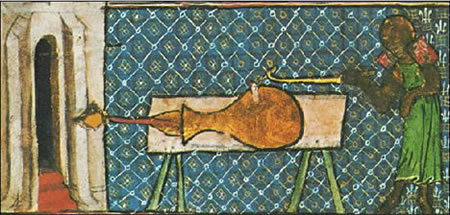- 01: Introduction
- 02: History
- 03: Propellants, Firearms, and Ammunition Development
- 04: Modern Firearms Manufacture
- 05: Small Arms Ammunition
- 06: Evidence Handling Procedures
- 07: Equipment and Instrumentation
- 08: Examination of Firearms
- 09: Cartridge and Shotshell Examination
- 10: Characterization and Evaluation of Fired Projectiles
- 11: Bullet Comparison and Identification
- 12: Gunshot Residue and Distance Determination
- 13: Toolmark Identification
- 14: Communicating Results
- Resources


Projectiles
Home > Propellants, Firearms, and Ammunition Development > Evolution of Firearms > Projectiles
From the standpoint of technology, the use of propellant materials for throwing nonpenetrating projectiles must be separated from their use for driving penetrating projectiles. An example of a non-penetrating projectile is the Roman candle, which is intended to airburst for entertainment or signaling. An example of a penetrating projectile is a rigid metal ball fired at high velocity.
Like black powder, the actual first use of firearms is lost in history. The first well-dated description and illustration of a penetrating projectile fired from cannon is found in the manuscript (1326) of Walter de Millimete. One illustration clearly shows a large spear loaded in a bottle-shaped cannon pointed at a building. Below, a soldier is shown holding a stick near the touchhole, where cannon barrels are pierced for the fuse.

There are unverified and questionable reports of the use of stone-firing cannon in 1247 in the defense of Seville as well as in 1301, in the German town of Amberg. It is obvious from Millimete and others that the first cannon were used in place of the ballista (a large, crew-served crossbow) to project large arrows and spear-like projectiles.
Frescoes painted by the Italian artist Paolo del Maestro Neri (1343) show foot soldiers holding tubes on sticks pointed at a castle. Wavy lines indicate the escape of smoke or flame from the end of the tubes. Illustrations from the fourteenth century depict soldiers holding a similar unaimed device with the left arm while the right hand holds a lighted, chemically treated rope (match) near the rear of the tube. Because this process is the same as used for lighting cannon via the touchhole, the term cannon lock is used for these small, hand-held cannon.
In the development of small arms, there are four significant areas that drove the evolution of firearms:
- Ignition systems
- Rifled gun barrels
- Breech-loading systems
- Repeating mechanisms




